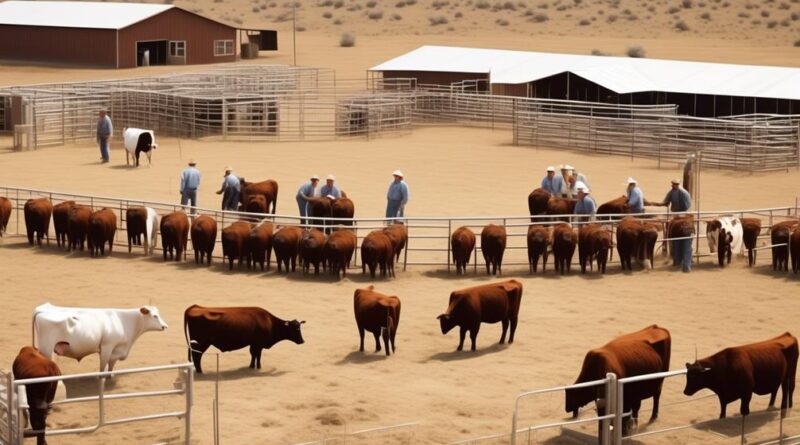6 Best Methods for Cattle Reproduction and Breeding
You might think that cattle reproduction and breeding methods are limited to natural mating, but there are actually several effective and advanced techniques that can enhance the breeding process.
From artificial insemination to reproductive technologies, there are various methods available to improve the efficiency and success of cattle breeding.
Understanding the benefits and considerations of each method is crucial for any cattle breeder looking to optimize their breeding program.
By exploring the six best methods for cattle reproduction and breeding, you can gain valuable insights into how to enhance your herd's reproductive performance and overall breeding success.
Natural Mating: Advantages and Considerations
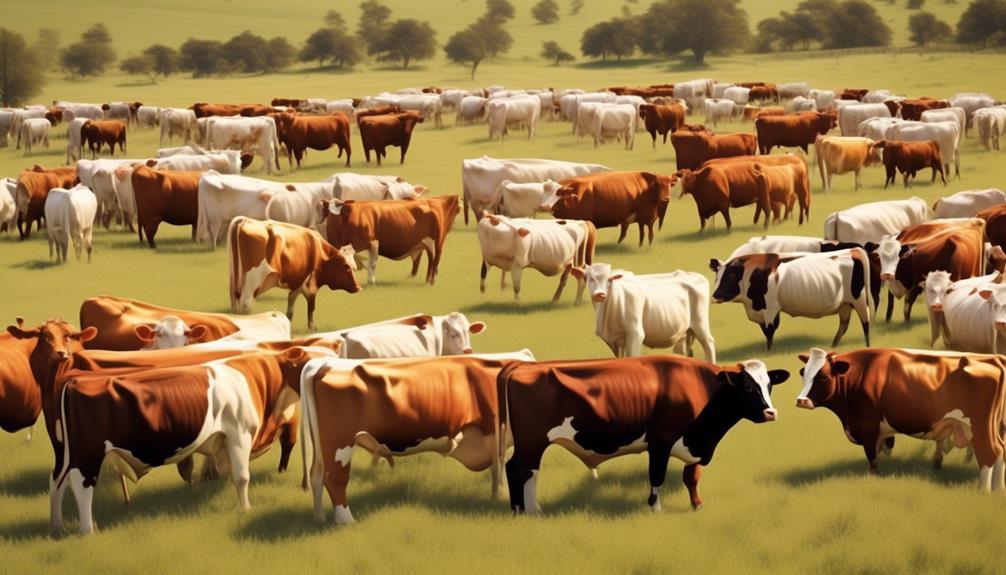
When considering cattle reproduction, natural mating offers various advantages and considerations that are important for successful breeding. Understanding the breeding behavior of cattle is crucial for optimizing natural mating.
Cattle are polyestrous, meaning they've multiple estrous cycles within a year. Typically, the mating season for cattle occurs in the spring and fall, coinciding with optimal forage availability. During this time, cows exhibit signs of heat, such as mounting other cows, bellowing, and increased physical activity. Bulls become more aggressive and vocal, actively seeking out cows in heat. This synchronization of mating behavior during the breeding season is essential for successful natural mating.
The natural mating process allows for the expression of natural mating behaviors, which can lead to higher conception rates. Bulls have the opportunity to exhibit their natural courtship behaviors, including sniffing, licking, and nuzzling the cows. This interaction can stimulate the release of hormones in the cows, increasing the likelihood of successful mating. Additionally, natural mating enables the selection of reproductively sound bulls and cows, as their ability to mate naturally indicates their fertility and physical fitness.
Considerations for natural mating include the need for proper bull to cow ratio, ensuring that each bull has an adequate number of cows to prevent overworking and exhaustion. It's also crucial to monitor the mating process to identify any potential issues, such as aggressive behavior or unsuccessful matings.
Understanding the advantages and considerations of natural mating is essential for effectively managing cattle reproduction and breeding.
Artificial Insemination: Process and Benefits
To optimize cattle reproduction beyond natural mating, you can explore the process and benefits of artificial insemination (AI). AI offers several advantages over natural mating, making it a popular choice for many cattle breeders. Here are some key points to consider:
- Increased AI Success Rates:
- AI allows for the use of semen from superior bulls with proven genetic traits.
- Results in higher success rates compared to natural mating.
- Leads to a more efficient and reliable breeding process.
- Enhanced Genetic Diversity in AI:
- By using AI, you have access to a wide range of genetically diverse bulls.
- Helps prevent inbreeding and improve the overall genetic diversity of your herd.
- Contributes to the long-term health and productivity of your cattle.
- Controlled Breeding and Reproduction:
- AI provides greater control over the timing of breeding.
- Allows for more precise management of reproductive cycles.
- Beneficial for coordinating breeding with market demand or specific production goals.
- Reduced Risk of Injury and Disease Transmission:
- With AI, the need for physical interaction between bulls and cows is minimized.
- Reduces the risk of injuries to both animals.
- Decreases the potential for disease transmission during mating.
- Contributes to overall herd health and well-being.
Factors Affecting Natural Mating Success
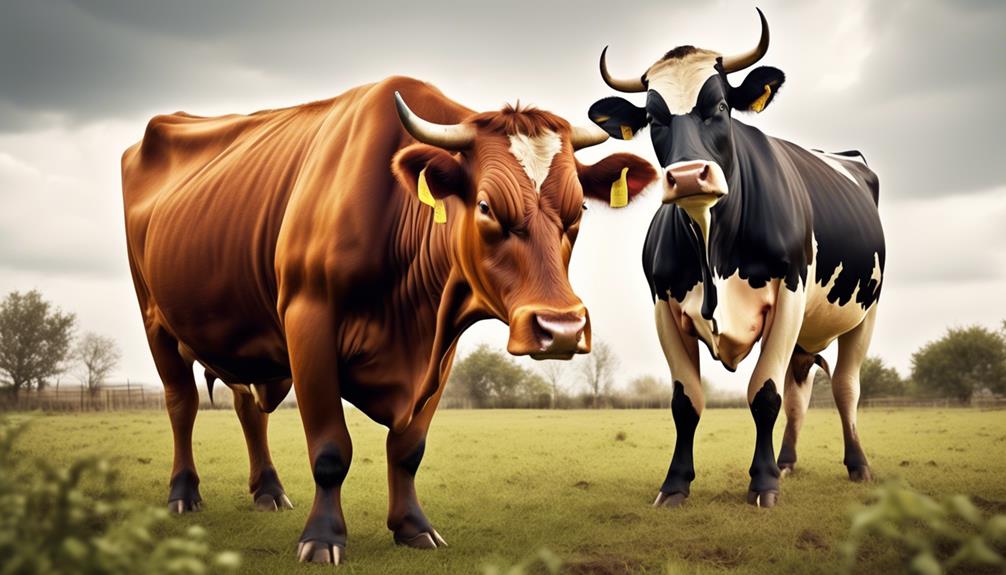
Understanding the key factors that influence natural mating success is essential for optimizing cattle reproduction and breeding outcomes. Synchronization methods play a crucial role in ensuring successful natural mating. By synchronizing the estrous cycle of the female cattle, farmers can increase the likelihood of successful breeding. This can be achieved through various methods such as hormonal treatments or using synchronization protocols, allowing for a more efficient and effective natural mating process.
Breeding season restrictions also significantly impact natural mating success. It's essential to consider the timing of the breeding season, as environmental factors and the availability of resources can affect the mating behavior of cattle. By understanding the natural breeding tendencies of the cattle, farmers can strategically plan the breeding season to maximize mating success. Additionally, proper management of breeding season restrictions can help avoid potential reproductive issues and ensure healthier offspring.
It's important to note that while natural mating is influenced by various factors, proper management and understanding of these factors can significantly improve mating success rates. By implementing synchronization methods and carefully considering breeding season restrictions, farmers can enhance the overall reproductive efficiency of their cattle.
Sperm Collection and Storage for AI
Proper storage of collected sperm is crucial for maintaining its viability and ensuring successful artificial insemination (AI). When it comes to sperm collection and storage for AI, there are several key considerations to keep in mind:
- Collection Techniques: Utilize proper collection techniques to ensure the highest quality of semen. This may involve using electroejaculation or manual massage to collect the sperm from the bull.
- Semen Preservation: Once collected, the semen must be properly preserved to maintain its viability. This can be achieved through dilution with a specialized extender that supports the survival of the sperm during storage and transportation.
- Cryogenic Storage: Long-term storage of semen is typically done through cryopreservation. The semen is mixed with a cryoprotectant and then frozen using liquid nitrogen, allowing it to be stored for extended periods while maintaining its fertility.
- Quality Control: Regularly monitor and assess the quality of the stored semen to ensure that it remains viable for AI. This may involve periodic evaluation of sperm motility, concentration, and morphology to identify any potential degradation.
Reproductive Technologies in Cattle Breeding
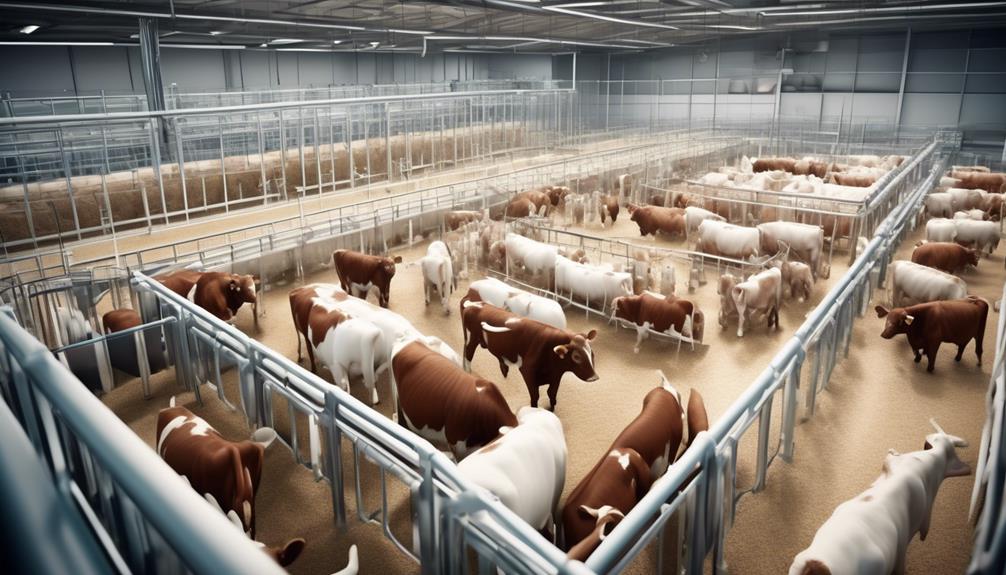
Reap the benefits of advanced reproductive technologies in cattle breeding by incorporating modern methods for enhancing genetic progress and breeding efficiency.
Embryo transfer is a key reproductive technology that allows you to multiply the impact of outstanding females in your herd. By using this method, you can collect embryos from your best cows and transfer them to recipient females, thereby increasing the number of offspring from your top genetic performers. This not only accelerates genetic improvement but also allows you to spread superior genetics more widely within your herd.
Genetic selection is another crucial aspect of reproductive technologies in cattle breeding. With the help of advanced genetic testing, you can identify the most desirable traits in your cattle and make more informed breeding decisions. This can lead to faster progress in achieving your breeding goals, whether it's improving milk production, enhancing meat quality, or increasing resistance to diseases.
Reproductive hormones play a vital role in managing the fertility of your cattle. By utilizing reproductive hormones, you can synchronize estrus cycles, improve conception rates, and better control the timing of breeding. This level of fertility management can significantly increase the efficiency of your breeding program, resulting in more successful pregnancies and higher-quality offspring.
Incorporating these reproductive technologies into your breeding program can revolutionize the way you manage your cattle's reproductive processes, ultimately leading to a more productive and genetically superior herd.
Managing Breeding Programs for Natural Mating
To optimize the genetic potential of your cattle herd through natural mating, it's essential to implement efficient breeding programs that capitalize on the strengths of your individual animals. Here are some key strategies for managing breeding programs for natural mating:
- Understanding Breeding Season: Familiarize yourself with the natural breeding season of your cattle. This knowledge will enable you to align the mating period with the optimal time for conception, enhancing the chances of successful reproduction.
- Selective Bull Management: Identify and maintain high-quality bulls with robust fertility and breeding capacity. Regularly assess their reproductive health and ensure they're in prime condition for natural mating.
- Fertility Management: Implement a comprehensive fertility management program for your cows. This may include regular veterinary check-ups, nutritional assessments, and strategic breeding protocols to maximize the fertility of your herd.
- Monitoring Reproductive Performance: Keep detailed records of each cow's reproductive performance. This will help you identify any fertility issues early on and take necessary measures to improve breeding outcomes.
AI Vs. Natural Mating: Cost and Efficiency
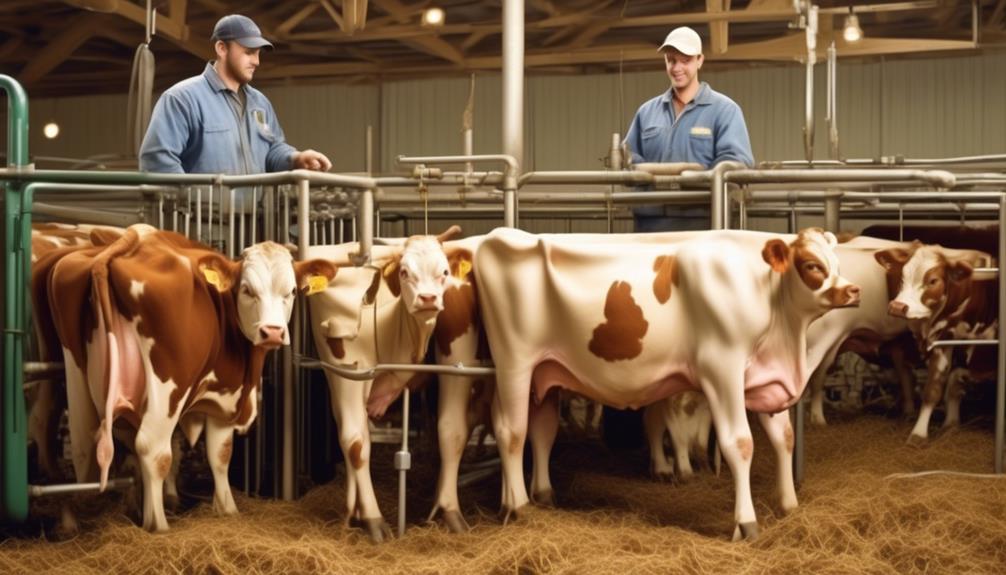
Comparing the cost and efficiency of artificial insemination (AI) versus natural mating provides valuable insights for optimizing your cattle breeding program.
When considering cost comparison, AI initially requires a higher investment due to the need for specialized equipment, trained technicians, and storage facilities for semen. However, in the long run, AI can be more cost-effective as it allows for the use of superior genetics without the need to maintain a bull on the farm.
On the other hand, natural mating may have lower initial costs, but it necessitates the upkeep of a bull, including feeding, housing, and veterinary care, which can accumulate significant expenses over time.
In terms of breeding efficiency, AI offers precise control over the genetics of the offspring, allowing for the selection of desirable traits and the use of high-quality semen from proven sires. This can lead to faster genetic improvement within the herd. Additionally, AI enables the simultaneous insemination of multiple cows with a single ejaculate, maximizing the use of superior genetics.
However, natural mating allows for the expression of natural mating behaviors, potentially resulting in higher conception rates due to the interaction between the bull and cow.
Ultimately, the choice between AI and natural mating depends on your specific breeding goals, resources, and management capabilities. Consider the cost comparison and breeding efficiency to determine the most suitable method for your operation.
Enhancing Reproductive Performance in Cattle
Enhancing the reproductive performance of your cattle can build upon the cost and efficiency considerations discussed in the comparison of artificial insemination (AI) versus natural mating. To further improve reproductive performance, consider the following:
- Reproductive Nutrition: Providing your cattle with proper nutrition is crucial for enhancing their reproductive performance. Ensure that your cattle receive a balanced diet rich in essential nutrients such as protein, minerals, and vitamins. Adequate nutrition supports overall health and can have a significant impact on the reproductive capabilities of your herd.
- Breeding Seasonality: Understanding the natural breeding seasonality of your cattle can help optimize reproductive performance. By aligning breeding practices with the natural reproductive cycles of your herd, you can improve breeding efficiency and increase the likelihood of successful matings.
- Monitoring Reproductive Health: Regular monitoring of reproductive health is essential for identifying and addressing any potential issues that could impact the fertility of your cattle. Work closely with a veterinarian to establish a comprehensive reproductive health management plan.
- Genetic Selection: Consider incorporating genetic selection into your breeding program to enhance the reproductive performance of your herd. By selectively breeding cattle with desirable reproductive traits, you can work towards improving the overall reproductive capabilities of your cattle.
Frequently Asked Questions
What Are the Potential Risks and Challenges Associated With Using Reproductive Technologies in Cattle Breeding?
Using reproductive technologies in cattle breeding can pose potential risks and challenges. Ethical considerations, health impacts, and maintaining genetic diversity are crucial. Successful integration requires careful planning and monitoring to address these concerns effectively.
How Can Producers Effectively Manage the Genetic Diversity of Their Cattle Herd When Using Artificial Insemination?
To effectively manage the genetic diversity of your cattle herd when using artificial insemination, focus on selecting diverse sires and regularly evaluating breeding efficiency. This approach allows for maintaining a healthy and genetically varied herd.
Are There Any Ethical Considerations to Take Into Account When Using Reproductive Technologies in Cattle Breeding?
When using reproductive technologies in cattle breeding, consider ethical considerations like animal welfare, social implications, and environmental impact. Ensure that the methods used prioritize the well-being of the animals and minimize negative effects on the environment.
What Are the Long-Term Impacts on the Health and Well-Being of Cattle When Using Artificial Insemination Versus Natural Mating?
Using artificial insemination or natural mating can impact the long-term health and well-being of cattle. Ethical considerations, genetic diversity management, and potential health implications should be taken into account when choosing a breeding method.
How Can Producers Ensure the Successful Integration of Both Natural Mating and Artificial Insemination in Their Breeding Programs?
To ensure successful breeding, integrate natural mating and artificial insemination while managing diversity and considering health impacts and ethical considerations. Reproductive technologies can enhance breeding success, but balancing methods is crucial for ethical and effective cattle reproduction.
Conclusion
In conclusion, when it comes to cattle reproduction and breeding, there are various methods available to optimize success. Whether it's natural mating, artificial insemination, or reproductive technologies, each approach has its own advantages and considerations.
It's important to consider factors such as cost, efficiency, and reproductive performance when deciding which method to use for your cattle breeding program.
By understanding and implementing the best methods, you can improve the overall success of your cattle reproduction and breeding efforts.
